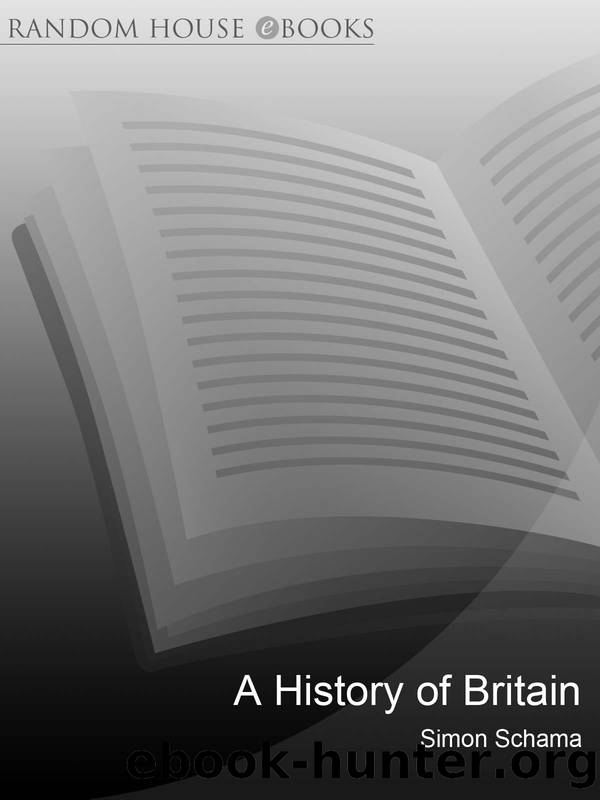A History of Britain, Volume 1 by Simon Schama

Author:Simon Schama
Language: eng
Format: epub
Publisher: Random House
Published: 2009-11-05T00:00:00+00:00
So as they emerged from the woods into the sight of the English, the Scots soldiers knelt to pray. Seeing this, amidst general merriment Edward asked his entourage: âWhat! Will those Scots fight?â On being assured they would, the king assumed they were kneeling for mercy and was told by one of his Scots allies that they did, indeed, seek mercy, ânot from the king but from Godâ.
From the beginning it was apparent that this was to be no repeat of Falkirk. Under the impact of the first tremendous charge, led by the Earl of Gloucester, the schiltrons stood fast, inflicting enormous damage by aiming their spears first at horses, then at the fallen riders. They were impenetrable to the mounted knights, and only the archers might have been able to break the tight cohesiveness of the schiltrons, but they were kept in the rear of the English attack until the battle was well under way. Perhaps it was hard to believe that, sooner or later, the repeated charges of the knights would not take their toll, as they had at Falkirk. When it became evident that this was not going to happen, the archers were belatedly moved up into firing position, but their passage was blocked by the debris of fallen horses and men, giving time for the small, mobile troop of Scottish cavalry to attack them headlong. Scattering, the Welsh and Gascon bowmen were taken out of the battle, and the conflict turned into an elemental hacking between the spears and axes of the Scots and the swords and lances of the knights. âMany a mighty splendid blow was struck by both sides until blood burst out of the coats of mail and ran streaming down into the earth.â Gradually, the English vanguard became unhorsed, lost its coherence and turned into a disorganized mass, trapped between the now slowly advancing schiltrons and the deep, muddy ditch of the burn. At some point in the afternoon an irregular crowd of Scottish peasants and yeomen, whom Bruce had kept in reserve sensing that the English were on the defensive, and who were armed with flails, hammers and pitchforks, charged down towards the fray. In the confusion the English commanders might well have imagined this to be a second and fresh Scots army. More to the point, they were certain that the king was now in personal peril and urged flight before he was captured or killed.
Edward II, who had certainly not shrunk from combat and who had had horses killed under him, was finally persuaded to depart. He left behind on the battlefield his personal shield and seal (later gallantly returned by King Robert), his personal belongings and clothes, what was left of his reputation as a battle captain and 4000 dead â English, Welsh, Gascon and Scots enemies of the Bruces. The burn was âso choked that men could pass over it with dry feet on the bodies of horses and menâ. âMaydens of Englonde, sore may ye morne,â wrote the Scots author of Fabyanâs Chronicles.
Download
This site does not store any files on its server. We only index and link to content provided by other sites. Please contact the content providers to delete copyright contents if any and email us, we'll remove relevant links or contents immediately.
Magic and Divination in Early Islam by Emilie Savage-Smith;(1517)
Bohemians, Bootleggers, Flappers, and Swells: The Best of Early Vanity Fair by Bohemians Bootleggers Flappers & Swells- The Best of Early Vanity Fair (epub)(1370)
Ambition and Desire: The Dangerous Life of Josephine Bonaparte by Kate Williams(1366)
Papillon by Henry Charrière(1363)
Twelve Caesars by Mary Beard(1296)
Operation Vengeance: The Astonishing Aerial Ambush That Changed World War II by Dan Hampton(1149)
What Really Happened: The Death of Hitler by Robert J. Hutchinson(1146)
London in the Twentieth Century by Jerry White(1127)
Time of the Magicians by Wolfram Eilenberger(1112)
The Japanese by Christopher Harding(1109)
Twilight of the Gods by Ian W. Toll(1105)
Lenin: A Biography by Robert Service(1065)
The Devil You Know by Charles M. Blow(1007)
A Social History of the Media by Peter Burke & Peter Burke(961)
Freemasons for Dummies by Hodapp Christopher;(949)
Napolean Hill Collection by Napoleon Hill(920)
Henry III by David Carpenter;(908)
The Churchill Complex by Ian Buruma(894)
The Rise and Triumph of the Modern Self by Unknown(893)
